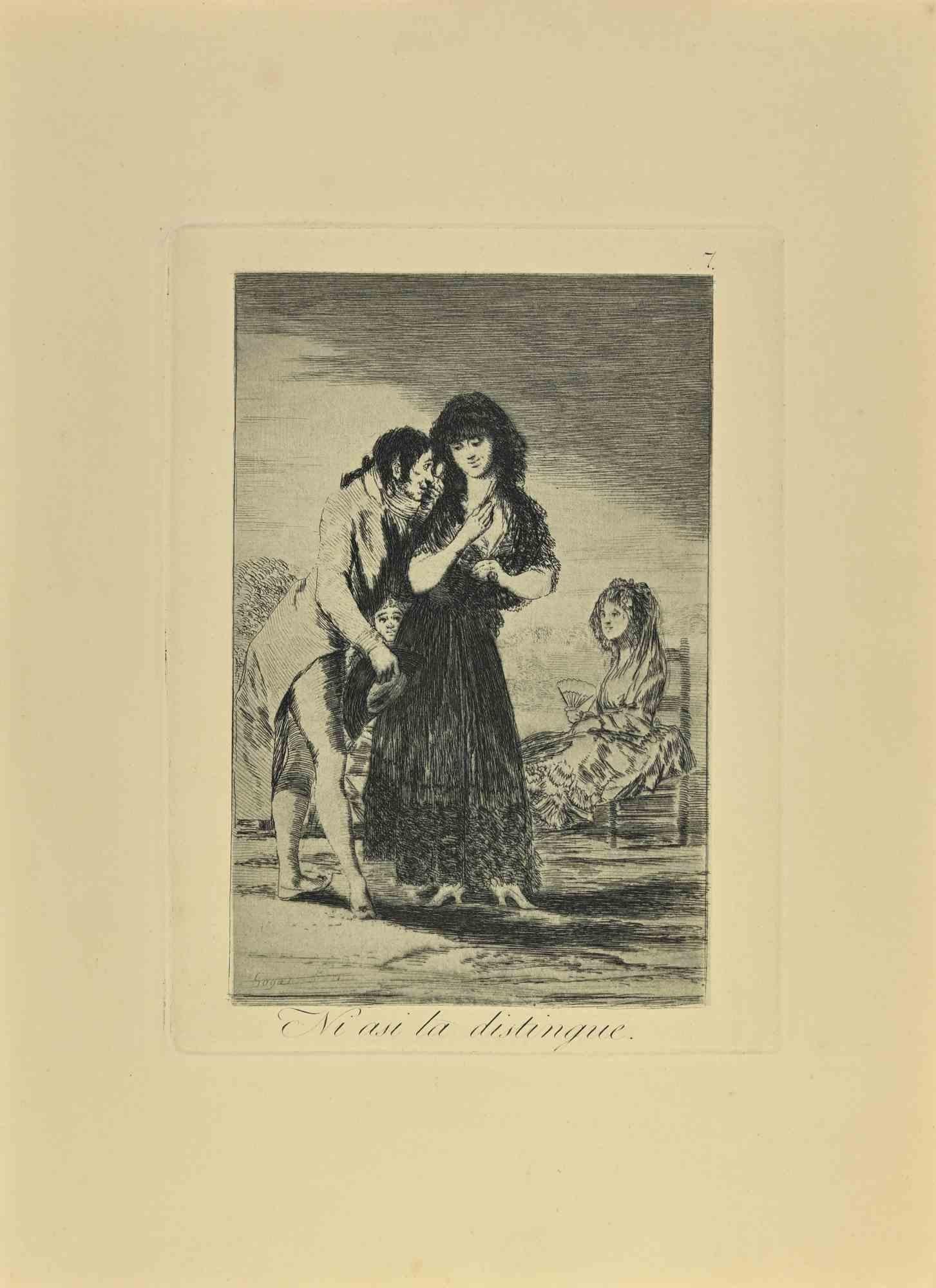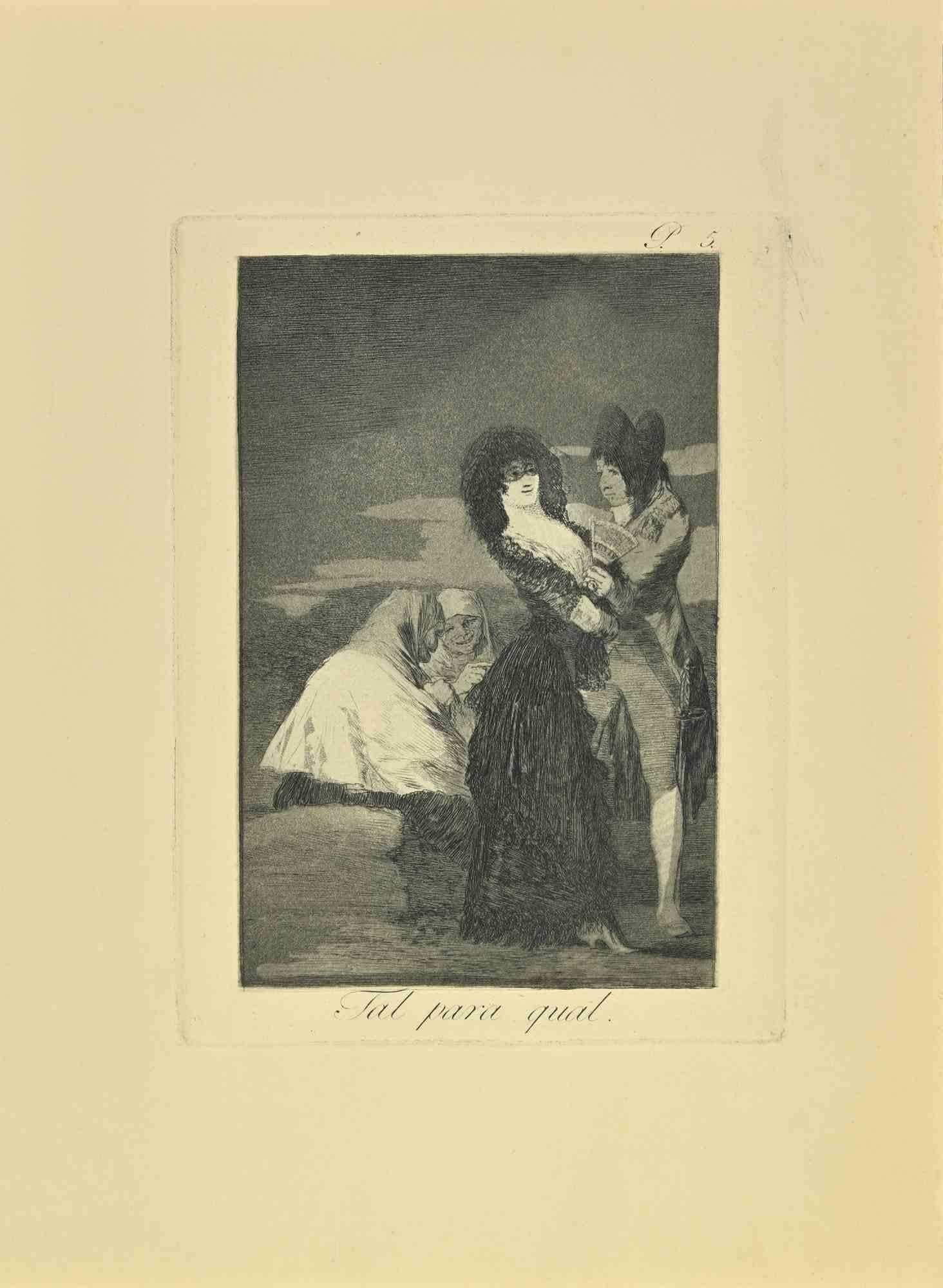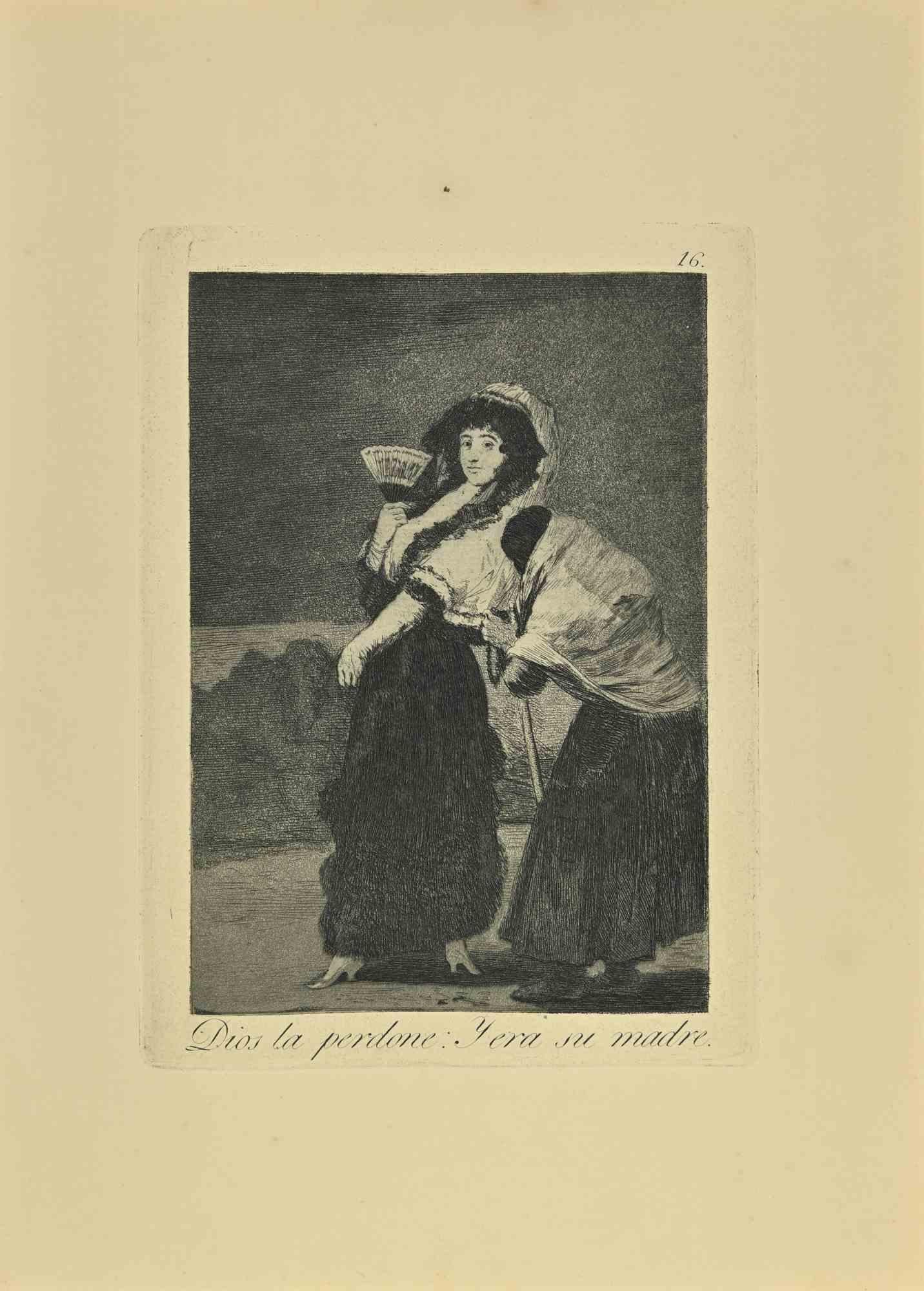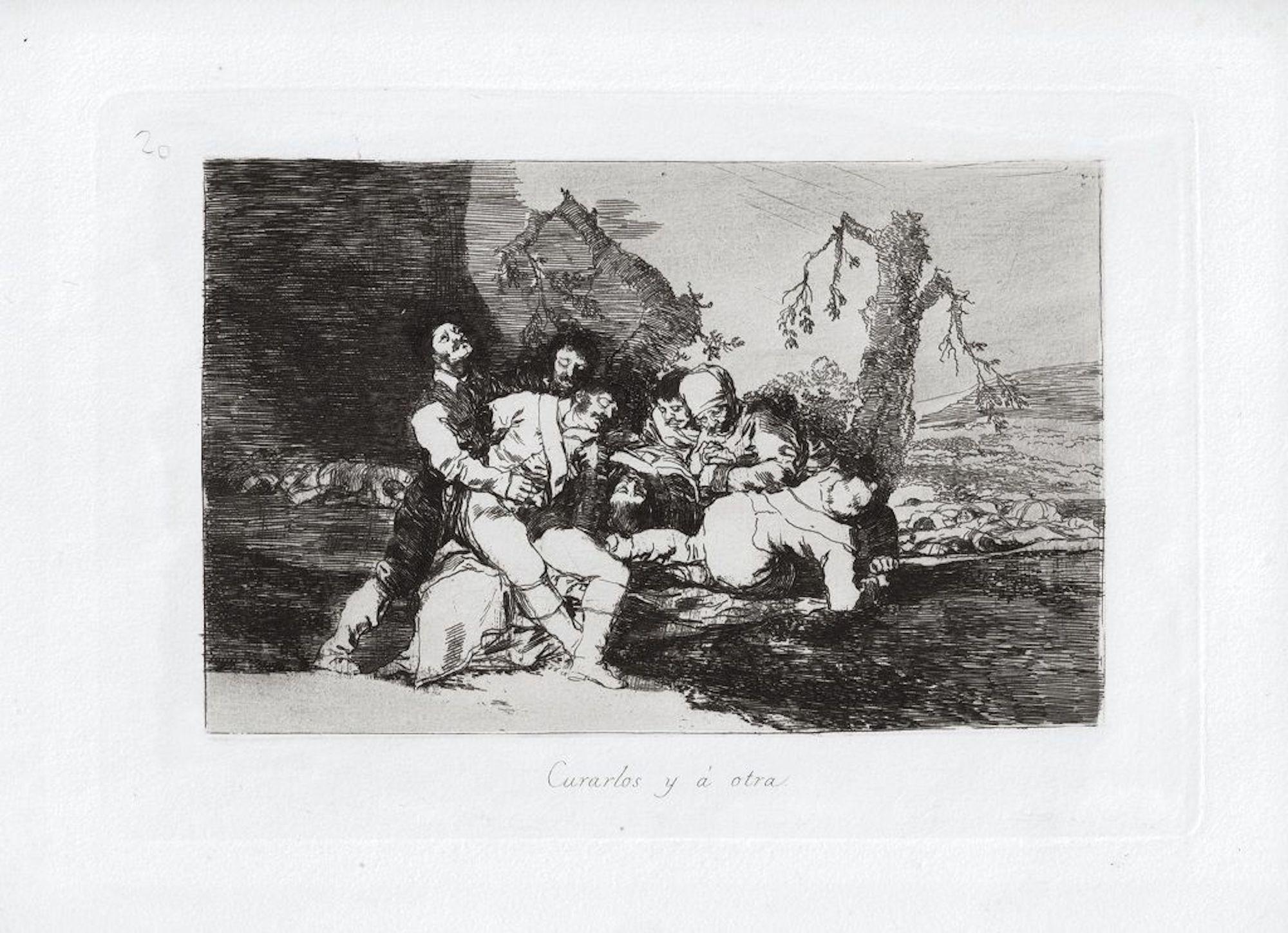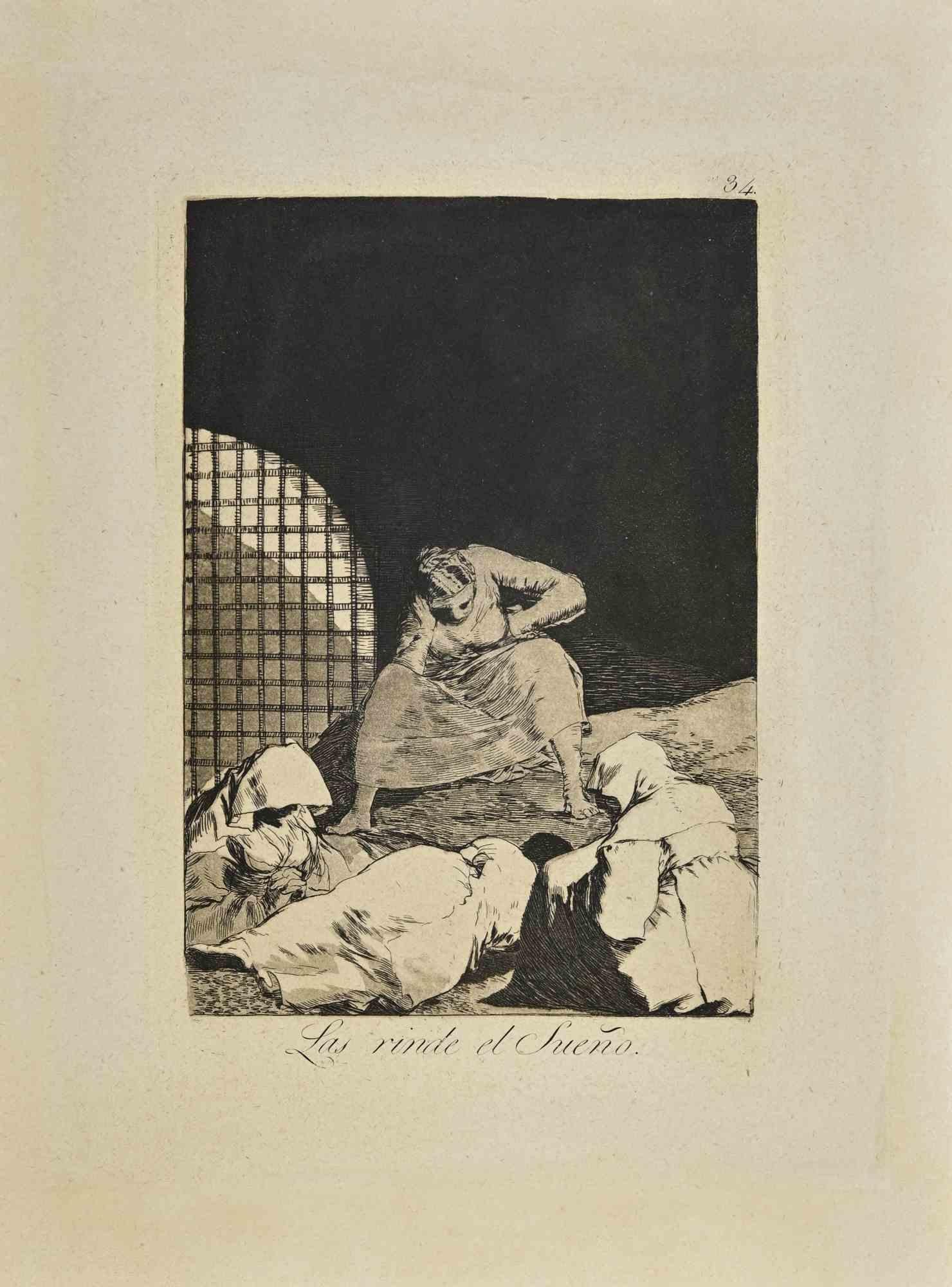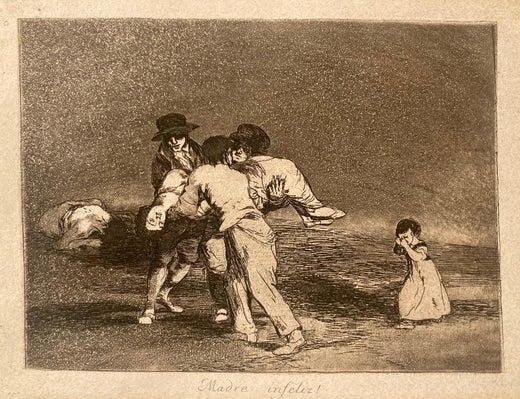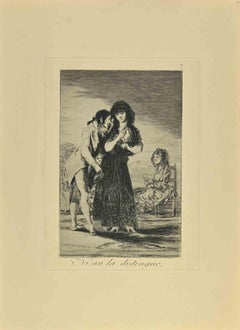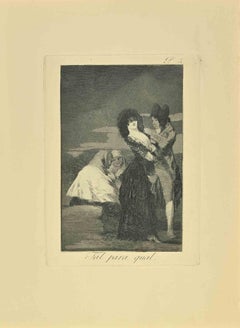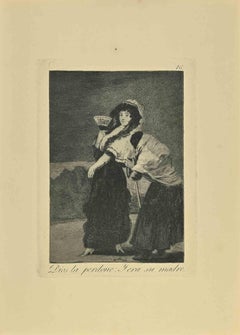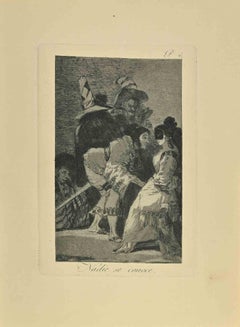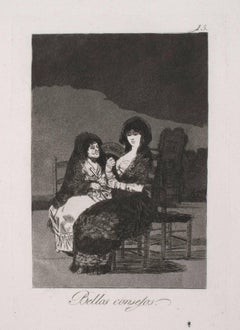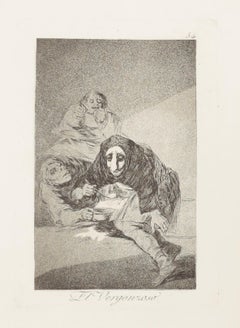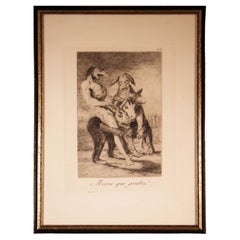Items Similar to Ni asi la Distingue - Etching by Francisco Goya - 1799
Want more images or videos?
Request additional images or videos from the seller
1 of 4
Francisco GoyaNi asi la Distingue - Etching by Francisco Goya - 17991799
1799
$6,694.75
£4,996.45
€5,600
CA$9,234.90
A$10,101.47
CHF 5,318.70
MX$120,601.22
NOK 67,787.56
SEK 62,009.44
DKK 42,662.79
About the Item
"Ni asi la Distingue" is an original aquatint realized by Francisco Goya in 1799, from Los Caprichos series, Plate 7, first edition.
Rare and in very good conditions.
Los Caprichos
Put on sale the 6 February 1799, at the end of the last carnival of the century, Los Caprichos, first Goya’s printed cycle created as a unit, can be located in a period of transition in the artist’s life. Actually, in the last decade of the eighteenth century, there were some facts very important for Goya, as the illness and the hearing loss.
These engravings are made in 1797 in Madrid, after the artist’s stay in Andalusia, where he was guest of the Duchess of Alba.
In 1797 Gaspar Melchor de Jovellanos, the most important deputy of the spanish Age of Enlightenment and Goya’s protector, accepted the Ministry of Mercy and Justice and started to promote a splendid environment for the artistic expression. The same year, the first version of this set (72 engravings) was printed entitled as Sueño 1º Idioma Universal. In january of 1799, the definitive edition (80 engravings) of the Caprichos was published.
This cycle can be divided into two parts, each of these is introduced by a self-portrait of the artist.
In the first self-portrait, that anticipates 41 realistic scenes (2-42), Goya represents himself as a middle-class man who has a sarcastic vision of the world, the main subject of his Caprichos. In the second portrait, he images himself asleep amidst his drawing tools, with monsters behind him produced by the reason dulled.
The Caprichos are a strong aesthetic and social provocation; french poet Baudelaire said about Goya’s masterpiece: “ No one artist more than Goya dared the sense of the absurd possible. All these contortions, these bestial faces, these diabolic sneers are infused with humanity […] it’s impossible find the suture, the point of union between real and fantastic; it’s a line so unclear that also the finest analyst can’t draw, in an art that is, at the same time, so transcendent and natural”.
Francisco José de Goya y Lucientes (March 30th 1746 - Bordeaux, April 16th 1828), Francisco Goya, the Spanish painter and printer, was one of the rare artists that, through their work, not only gain the recognition and admiration of their contemporaries, but influence the development of future art.
Born in Fuentedetodos to a middle-class family originating from Aragona, he was the forth of six brothers.
Studying with José Buzàn y Martinez, and in Madrid under Velasquez, and entered the group of R. Mengs where he met Tiepolo. After going to Roma and Venice, he returned to Spain to paint the dome of Santa Maria of Pilar basilica in Zaragoza with frescoes showing Tiepolo's influence. In Madrid he was uncomfortable with his academic style, despite the fame gained in the king's court for his very lively style and refined artistic taste. He had started his most productive and busy period of his life. He returned to Zaragoza to paint frescoes in the cathedral (commissioned by Bayeu) but left the work incomplete and instead started to paint portraits and also started “Caprichos”.
Goya's main success was under the reign of Carlo IV but when the power of Ferdinandi VII increased under the French occupation, he went into exile in Bordeaux. In 1799 he painted the family portrait of Carlo IV and attracted the friendship of the king. Goya was close to the poor, something that is reflected in the “Desastres de la guerra” print, and to which he dedicated his work during his stay in France. Goya travelled to Zaragoza to paint the companies of the Spanish resistance, but left Spain for Bordeaux after the onset of deafness and painted the Milkmaid of Bordeaux. He died in Bordeaux in 1828.
- Creator:Francisco Goya (1746 - 1928, Spanish)
- Creation Year:1799
- Dimensions:Height: 12.21 in (31 cm)Width: 9.06 in (23 cm)Depth: 0.04 in (1 mm)
- Medium:
- Movement & Style:
- Period:1790-1799
- Condition:Insurance may be requested by customers as additional service, contact us for more information.
- Gallery Location:Roma, IT
- Reference Number:Seller: M-1063671stDibs: LU65036105422
Francisco Goya
Francisco José de Goya y Lucientes (1746-1828) was a Spanish romantic painter and printmaker. He is considered the most important Spanish artist of the late 18th and early 19th centuries. His works often contained a social message, like in his "Disasters of War" series. Immensely successful in his lifetime, Goya is often referred to as both the last of the Old Masters and the first of the moderns. He was also one of the great portraitists of his time.
About the Seller
4.9
Platinum Seller
Premium sellers with a 4.7+ rating and 24-hour response times
1stDibs seller since 2017
7,871 sales on 1stDibs
Typical response time: 1 hour
- ShippingRetrieving quote...Shipping from: Roma, Italy
- Return Policy
More From This Seller
View AllMi asi la Distingue - Etching and and Aquatint by Francisco Goya - 1881
By Francisco Goya
Located in Roma, IT
Mi asi la Distingue is a black and White aquatint, drypoint and etching printed in blue-black ink on laid paper from Caprichos realized after Francisco Goya in 1881-1886 .
6th Editi...
Category
1880s Modern Figurative Prints
Materials
Etching
Tal Para Qual - Etching and and Aquatint by Francisco Goya - 1881
By Francisco Goya
Located in Roma, IT
Tal Para Qual is a black and White aquatint, drypoint and etching printed in blue-black ink on laid paper from Caprichos realized after Francisco Goya in 1881-1886 .
6th Edition.Ver...
Category
1880s Modern Figurative Prints
Materials
Etching
Dios la Perdone: Y era su Madre - Etching by Francisco Goya - 1881
By Francisco Goya
Located in Roma, IT
Dios la perdone: Y era su madre is a black and White aquatint, drypoint, and etching printed in blue-black ink on laid paper from Caprichos realized after Francisco Goya in 1881-188...
Category
1880s Modern Figurative Prints
Materials
Etching
Nadie se Conoce - Etching and and Aquatint by Francisco Goya - 1881
By Francisco Goya
Located in Roma, IT
Nadie se Conoce is a black and White aquatint, drypoint and etching printed in blue-black ink on laid paper from Caprichos realized after Francisco Goya in 1881-1886 .
6th Edition.V...
Category
1880s Modern Figurative Prints
Materials
Etching
Curarlos y a Otra - Etching by Francisco Goya - 1863
By Francisco Goya
Located in Roma, IT
Curarlos y a otra is an original artwork realized by the great Spanish artist Francisco Goya in 1810. Original etching on paper.
The artwork belongs to the famous print collection L...
Category
1860s Old Masters Figurative Prints
Materials
Etching, Aquatint
Las Rinde el Sueno - Etching by Francisco Goya - 1881
By Francisco Goya
Located in Roma, IT
Las Rinde el Sueno is a black and White aquatint, drypoint and etching printed in blue-black ink on laid paper from Caprichos realized after Francisco Goya in 1881-1886 .
6th Editio...
Category
1880s Modern Figurative Prints
Materials
Etching
You May Also Like
Bellos Consejos (Wonderful Advice)
By Francisco Goya
Located in Chicago, IL
An impression from the 1st edition published in 1799, the only edition published during Goya's lifetime.
References: Los Caprichos Plate 15; Delteil 52; Harris 50 III.1
Prado ...
Category
18th Century and Earlier Old Masters Figurative Prints
Materials
Aquatint, Etching
The Custody is as Barbarous as The Crime, Etching by Francisco de Goya
By Francisco Goya
Located in Long Island City, NY
Francisco de Goya, Spanish (1746 - 1828) - The Custody is as Barbarous as The Crime, Year: circa 1810, Medium: Etching and burin on cream laid paper, Image Size: 3.75 x 3 inches, Si...
Category
1810s Surrealist Figurative Prints
Materials
Etching
El Vergonzoso (Plate 54) (Los Caprichos Series)
By Francisco Goya
Located in London, GB
Francisco Jose Goya Y Lucientes
El Vergonzoso (Plate 54)
(Los Caprichos Series)
1799
Etching with aquatint
31.5 x 20.5 cms (12.4 x 8.1 ins)
Category
Late 18th Century Figurative Prints
Materials
Etching
Francisco Goya Miren Que Grabes from Los Caprichos 1868 Etching Framed
By Francisco Goya
Located in Keego Harbor, MI
A macabre etching and aquatint on paper titled “Miren que grabes!” from Los Caprichos by Spanish artist Francisco Goya. Signed in the plate. Numbered 63 ...
Category
Antique 1860s Prints
Materials
Paper
Old Master Etching and Aquatint
By Francisco De Goya
Located in Tarrytown, NY
Plate #18 from Francisco de Goya's "Los Caprichos" series titled "Ysele Quema La Casa." Printed on wove paper. Double matted and contained under glass in an ebonized and parcel gilt ...
Category
Antique 19th Century Spanish Romantic Prints
Materials
Giltwood, Paper
TAMBIEN ESTO
By Francisco Goya
Located in Aventura, FL
Tambien esto / So is this (Disasters of War, plate 43, Harris 163, Delteil 162). Original etching, burnished aquatint, and burnisher, c. 1808-1814. The clergy are running; their floc...
Category
Early 19th Century Romantic Figurative Prints
Materials
Drypoint, Etching, Paper
$1,600 Sale Price
20% Off
More Ways To Browse
Antique Drawing Tools
Nature Woodblock
Norman Hirst
Norman Rockwell Clock
Norman Rockwell Tom Sawyer
Nude Flask
Nude With Garter Dali
Odilon Redon On Sale
Oli Epp
Original Etching Roman Emperor
Ota Masamitsu
Oyvind Fahlstrom On Sale
Pablo Picasso Signed Aquatint
Pablo Picasso The Kiss
Parc Monceau Harold Altman
Pegge Hopper Print
Peter Max 1972
Peter Max Angels Signed
